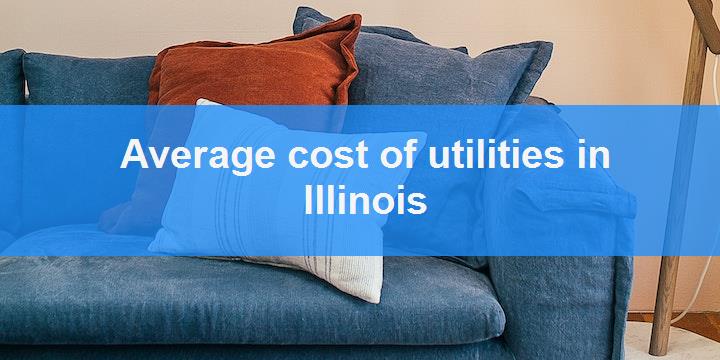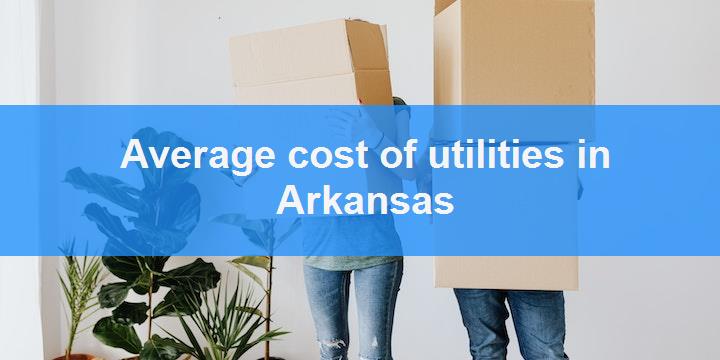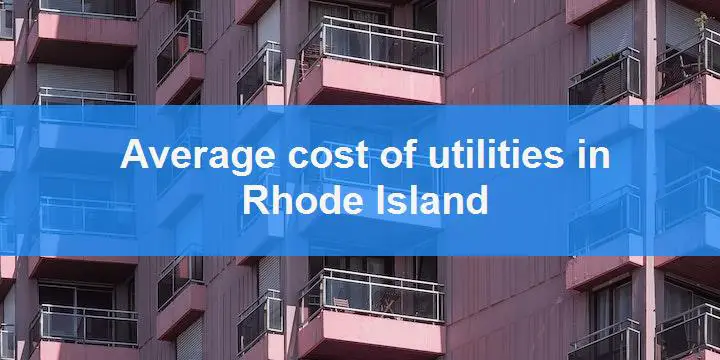Managing utility costs is a key part of household budgeting, especially in a state like Illinois, where seasonal temperature swings impact energy consumption. In 2025, the average cost of utilities for a family of three in a single-family home is $574.20. Illinois experiences extreme weather conditions, from scorching summers to frigid winters, which heavily influence monthly utility expenses. This guide provides a detailed breakdown of electricity, gas, and other essential utility costs to help you plan your budget more effectively.
Average Electric Bill in Illinois
Electricity is one of the most significant utility costs for Illinois residents, fluctuating throughout the year based on seasonal demands. In 2025, the average electric bill for a family of three in a single-family home is $161.94. Illinois’ diverse climate leads to higher heating costs in winter and increased air conditioning usage in summer.
Here’s a closer look at how electricity usage varies by season:
- Winter: Energy demand increases due to heating systems, refrigerators, dryers, and washers ($194.74).
- Summer: Air conditioning becomes the dominant energy expense, along with fridges, dryers, and washers ($129.14).
Illinois vs. Missouri: Summer Energy Cost Comparison
How does Illinois compare to its neighboring states when it comes to electricity expenses? The table below provides a detailed comparison of electricity costs for a large single-family home with four residents in Illinois and Missouri during the summer. This comparison helps highlight differences in energy pricing, climate impact, and household energy consumption.
| Criteria | Illinois | Missouri |
|---|---|---|
| Total Consumption (kWh) | 862.12 kWh | |
| Electricity Rate (cents/kWh) | 16.00 ¢/kWh | 12.84 ¢/kWh |
| Estimated Monthly Cost | $137.94 | $110.7 |
| Detailed Cost Breakdown | ||
| Base Usage: 412.12 kWh | $65.94 | $52.92 |
| Refrigerator: 120 kWh | $19.2 | $15.41 |
| Air Conditioner: 240 kWh | $38.4 | $30.82 |
| Clothes Dryer: 90 kWh | $14.4 | $11.56 |
| Illinois estimated monthly cost is higher than Missouri by 24.61%. | ||
Historical Electricity Price Trends
The chart above illustrates historical electricity price trends for large single-family homes in Illinois during the summer months. Analyzing these trends provides valuable insights into past price fluctuations, helping homeowners anticipate future changes and optimize their energy consumption.
Electricity Cost Comparison Across Various States
This table offers a comprehensive comparison of electricity costs across different states, considering various household types and seasons. It provides a broad perspective on utility expenses.
| State | People | Household Type | Season | Appliances | Electric Monthly Bill |
|---|---|---|---|---|---|
| New York | 3 | One-bedroom apartment | Summer | Fridge, AC, Dryer |
$148.77 |
| California | 4 | Single-family large | Winter | Heater, Dryer, Fridge |
$407.08 |
| Texas | 3 | Townhouse | Winter | Heater, Dryer, Fridge |
$168.56 |
| Florida | 3 | Single-family small | Summer | Fridge, AC, Washer |
$102.05 |
| Georgia | 2 | Studio | Winter | Heater, Fridge |
$123.20 |
| Washington | 3 | Single-family small | Summer | Fridge, AC, Dryer |
$91.30 |
| Illinois | 2 | Townhouse | Summer | Fridge, AC, Washer |
$106.00 |
For a more detailed and personalized utility expense estimate, check out our Electricity Bill Calculator. Adjust the parameters to match your household specifics and get an accurate estimate tailored to your needs.
Average Gas Bill in Illinois
Gas expenses are a significant part of household utility costs, particularly in a state like Illinois, where seasonal temperature changes drive energy consumption. In 2025, the average gas bill for a family of three living in a single-family home is $161.94. With cold winters increasing heating demand and hot summers requiring less gas usage, understanding seasonal variations can help manage costs more effectively.
Here’s how gas usage fluctuates throughout the year:
- Winter: Heating systems account for the largest portion of gas consumption, along with water heaters, stoves, and ovens ($237.20).
- Summer: Gas usage decreases, primarily used for grills, water heaters, stoves, and ovens ($86.67).
Illinois vs. Ohio: A Summer Gas Usage Comparison
How does Illinois compare to its neighbors when it comes to gas costs? The table below provides a side-by-side look at gas expenses for a large single-family home with four residents in Illinois and Ohio during the summer. This comparison highlights differences in gas pricing, consumption patterns, and seasonal demand.
Gas Bill Comparison Overview
| Criteria | Illinois | Ohio | Avg. USA |
|---|---|---|---|
| Total Consumption (MCF) | 6.99 MCF | ||
| Gas Rate ($/MCF) | $14.81 | $20.68 | $17.73 |
| Estimated Monthly Cost | $103.56 | $144.60 | $123.97 |
| Appliance Cost Breakdown | |||
| Outdoor Grill | $8.18 | $11.42 | $9.79 |
| Water Heater | $59.95 | $83.71 | $71.77 |
| Gas Stove | $13.63 | $19.03 | $16.31 |
| Gas Oven | $21.80 | $30.44 | $26.10 |
| Illinois's estimated monthly cost is lower than Ohio by 28.38%. | |||
| Illinois's estimated monthly cost is lower than the Avg. USA by 16.46%. | |||
Gas costs can vary between Illinois and Ohio due to factors like climate, infrastructure, and household energy efficiency. Understanding these regional differences can help homeowners optimize their energy consumption.
The chart above tracks historical gas price trends for large single-family homes in Illinois during the summer months. Analyzing these trends can provide insight into past price fluctuations and help predict future costs, allowing residents to make informed decisions about their energy usage.
Gas Cost Comparison Across Various States
Here is a detailed comparison of gas costs across different states, considering various household types and seasons. This table offers a comprehensive view of utility expenses.
| State | People | Household Type | Season | Appliances | Gas Monthly Bill |
|---|---|---|---|---|---|
| New York | 3 | Townhouse | Summer | Water heater, Stove, Oven |
$88.71 |
| Hawaii | 2 | Studio | Summer | Water heater, Stove, Oven |
$144.62 |
| Vermont | 4 | Single-family small | Winter | Gas heating, Dryer, Oven |
$298.95 |
| Texas | 3 | Townhouse | Winter | Gas heating, Dryer, Oven |
$279.14 |
| Indiana | 3 | Single-family small | Summer | Water heater, Stove, Oven |
$78.75 |
| South Carolina | 4 | Single-family large | Summer | Water heater, Stove, Oven |
$134.85 |
| Michigan | 2 | Studio | Winter | Gas heating, Dryer, Oven |
$99.20 |
This comparison table offers a broad perspective on how gas costs vary across different states and household setups, helping you make more informed decisions about your energy usage.
For a detailed and personalized utility expense estimate, explore our Gas Bill Calculator. Customize the parameters to fit your household specifics and get an accurate estimate tailored to your needs.
Average Water and Sewer Bill in Illinois
Water and sewer expenses are a key part of household budgeting, especially for those considering a move to or investment in Illinois. In 2025, the average water and sewer bill in Illinois is $46.00. These costs vary depending on location, infrastructure, and conservation efforts, making it essential to plan accordingly.
Comparing Water and Sewer Fees Across States
To understand how Illinois stacks up regionally, here’s a comparison of average water and sewer costs in eight neighboring states:
| State | Average Water and Sewer Fees |
|---|---|
| Indiana | $51.00 |
| Wisconsin | $48.00 |
| Michigan | $49.00 |
| Missouri | $59.00 |
| Iowa | $49.00 |
| Kentucky | $69.00 |
| Ohio | $57.00 |
| Minnesota | $48.00 |
Illinois’ water and sewer fees remain competitive, especially when compared to states like Wisconsin and Michigan, where costs tend to be higher due to aging infrastructure and high demand.
How Illinois’ Infrastructure Impacts Water Costs
Illinois has made significant investments in water management infrastructure, providing residents with several advantages:
- Green Roofs: Urban areas utilize green roofs to reduce runoff and enhance water absorption, lowering strain on sewer systems.
- Rain Gardens: These natural filtration systems help absorb stormwater, reducing flooding risks.
- Advanced Metering Infrastructure (AMI): Smart water meters allow real-time monitoring to detect leaks early and optimize water usage.
- Public-Private Partnerships: Collaborations between government and private entities drive innovation in water management projects.
Statewide Water Conservation Programs
Illinois offers several programs to help residents save on water expenses while promoting sustainability:
- Rebates for Water-Efficient Appliances: Homeowners can receive incentives for upgrading to water-saving toilets, faucets, and irrigation systems.
- Community Education Initiatives: Local programs educate residents on reducing water waste and implementing conservation strategies.
- Grants for Sustainable Water Projects: Funding opportunities are available for communities investing in eco-friendly water infrastructure.
Environmental Stewardship in Illinois
Illinois prioritizes long-term water sustainability, ensuring high-quality water access for future generations. These initiatives not only enhance residents’ quality of life but also protect natural ecosystems across the state.
Final Thoughts
With competitive water and sewer rates, modern infrastructure, and proactive conservation efforts, Illinois remains a practical and sustainable choice for homeowners and investors. Staying informed about utility costs allows for better budgeting and smarter real estate decisions. If you need expert advice, our team is here to help you navigate Illinois’ real estate market with confidence.
Garbage/Trash Removal Costs in Illinois
Managing garbage and trash removal expenses is an important aspect of household budgeting in Illinois. In 2025, the average cost for garbage and trash removal services in Illinois is $29.00. These costs vary based on factors such as service provider, pick-up frequency, and whether recycling services are included in the package.
Illinois has a well-developed waste management system that emphasizes recycling and landfill reduction. Many municipalities provide curbside recycling and composting programs, which can impact overall garbage removal costs. Homeowners may also have the option to choose between municipal and private waste collection services.
Comparing Garbage/Trash Removal Costs Across States
To offer a broader perspective, here’s a comparison of **average garbage and trash removal costs** in Illinois and other states:
| State | Average Cost |
|---|---|
| Illinois | $29.00 |
| Indiana | $21.00 |
| Wisconsin | $24.00 |
| Michigan | $28.00 |
| Iowa | $25.00 |
| Missouri | $23.00 |
| Ohio | $26.00 |
| Kentucky | $23.00 |
| Minnesota | $27.00 |
| Tennessee | $24.00 |
Illinois’ garbage removal costs tend to be higher than in states like Indiana and Missouri, primarily due to its extensive recycling initiatives and stricter waste management regulations. However, these programs contribute to environmental sustainability and long-term cost efficiency.
For homeowners looking to reduce their waste disposal expenses, options such as composting, reducing waste production, and using municipal recycling programs can be beneficial.
Internet and Cable TV Expenses in Illinois
Reliable internet and cable TV services are essential for both work and entertainment. In 2025, the average internet and cable TV expense in Illinois is $110.66. However, costs can vary depending on provider, location, and service package.
With a high density of service providers, Illinois residents have access to competitive pricing and quality service. The presence of fiber-optic networks and regional broadband expansions has further improved connectivity in many parts of the state.
Comparison of Internet and Cable TV Providers in Illinois
Here’s a breakdown of pricing from major providers in Illinois:
| Provider | Internet Price | Cable TV Price | Bundle Price |
|---|---|---|---|
| Comcast | $56.99 | $67.99 | $111.99 |
| Verizon | $57.99 | $68.99 | $118.99 |
| AT&T | $52.99 | $63.99 | $100.99 |
With a variety of plans available, it’s important to compare options based on factors like download speeds, channel selection, contract flexibility, and bundling discounts.
How Illinois’ Internet and Cable Costs Compare to Other States
For a regional comparison, here’s how Illinois’ internet and cable TV costs stack up against nearby states:
- Indiana: $109.66
- Wisconsin: $113.66
- Missouri: $113.66
- Iowa: $114.66
- Michigan: $112.66
- Ohio: $112.66
- Kentucky: $112.66
- Minnesota: $111.66
Illinois’ costs remain moderate compared to states like Indiana and Wisconsin, where fewer service providers can sometimes lead to higher prices or limited options. Exploring different plans and promotions is key to securing the best deal.
Tips for Reducing Internet and Cable Expenses
To optimize your budget and get the most out of your internet and cable TV services, consider the following:
- Compare Plans Regularly: Providers frequently update their pricing and promotions, so checking periodically can help you find better deals.
- Bundle Services: Combining internet, cable, and phone services may lead to **discounted bundle rates**.
- Negotiate with Providers: Many companies offer promotional pricing for new customers, and existing customers can often negotiate for better rates.
- Consider Streaming Services: If cable TV costs are too high, switching to streaming platforms may provide a more affordable alternative.
By staying informed and evaluating different options, Illinois residents can maximize their savings while ensuring high-quality internet and cable TV services. 🌐📺
Home Phone and Mobile Phone Costs in Illinois
Reliable phone service is essential for staying connected, whether at home or on the go. In 2025, the average home phone and mobile phone cost in Illinois is 64.66. However, these expenses can vary based on location, provider, and service plan.
Illinois residents benefit from a competitive telecom market, offering various service providers that help keep prices in check while maintaining high-quality coverage.
Comparison of Home and Mobile Phone Providers in Illinois
Below is a breakdown of pricing from major phone providers in Illinois:
| Provider | Mobile Phone Price | Home Phone Price |
|---|---|---|
| Verizon | $69.99 | $36.99 |
| AT&T | $64.99 | $31.99 |
| T-Mobile | $58.99 | Does not provide |
With a range of providers available, it’s important to compare coverage, contract terms, and bundled discounts to find the best deal for your needs.
How Illinois’ Phone Costs Compare to Other States
To provide additional context, here’s how Illinois’ home and mobile phone costs compare to neighboring states:
- Indiana: 65.66
- Wisconsin: 65.66
- Missouri: 66.66
- Iowa: 66.66
- Michigan: 68.32
- Ohio: 66.66
- Kentucky: 68.32
- Minnesota: 64.66
Illinois’ phone costs remain moderate compared to states like Indiana and Wisconsin, where fewer providers may lead to higher prices or limited options.
Strategies to Reduce Phone Expenses
To optimize costs and get the best value for your phone service, consider these cost-saving tips:
- Compare Plans Regularly: Providers frequently update their offerings, so checking for new deals can help you save money.
- Bundle Services: Many carriers offer **discounts when bundling mobile, home phone, and internet** services.
- Negotiate with Providers: If you’re an existing customer, call your provider and ask for loyalty discounts or promotional pricing.
- Consider Alternative Providers: Some smaller carriers and prepaid plans offer more competitive rates with no long-term contracts.
Final Thoughts
With a variety of providers and plans available, staying informed and comparing services regularly is the best way to ensure you’re getting the best deal. Phone prices and services change frequently, so it’s essential to monitor new promotions and updates. Our team updates this article monthly with the latest rates and insights, so be sure to check back often for the most up-to-date information. 📞📱
FAQ
Q: 💡 What is the average monthly electric bill in Illinois in 2025?
A: The average monthly electric bill for Illinois residents in 2025 is approximately $161.94.
Q: 🔥 What is the average monthly gas bill for Illinois residents in 2025?
A: The average monthly gas bill for Illinois residents in 2025 stands at approximately $161.94.
Q: 🚰 What is the average monthly water and sewer bill in Illinois in 2025?
A: The average monthly water and sewer bill in Illinois in 2025 is around $46.00.
Q: 🗑️ What is the average monthly garbage and trash removal cost in Illinois in 2025?
A: The average monthly garbage and trash removal cost in Illinois in 2025 is about $29.00.
Q: 📡 What is the average monthly internet and cable TV bill in Illinois in 2025?
A: The average monthly internet and cable TV bill in Illinois in 2025 is approximately $110.66.
Q: 📱 What is the average monthly home and mobile phone bill in Illinois in 2025?
A: The average monthly home and mobile phone bill in Illinois in 2025 is around 64.66.
Q: 🧾 What is the total average monthly cost of utilities in Illinois in 2025?
A: The total average monthly cost of utilities in Illinois in 2025 is approximately $574.20.



